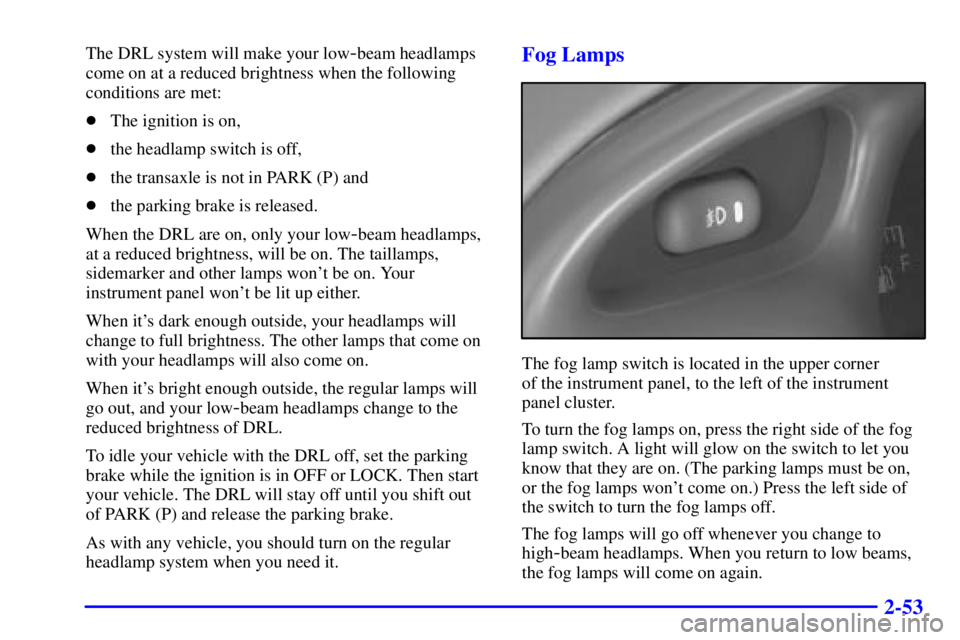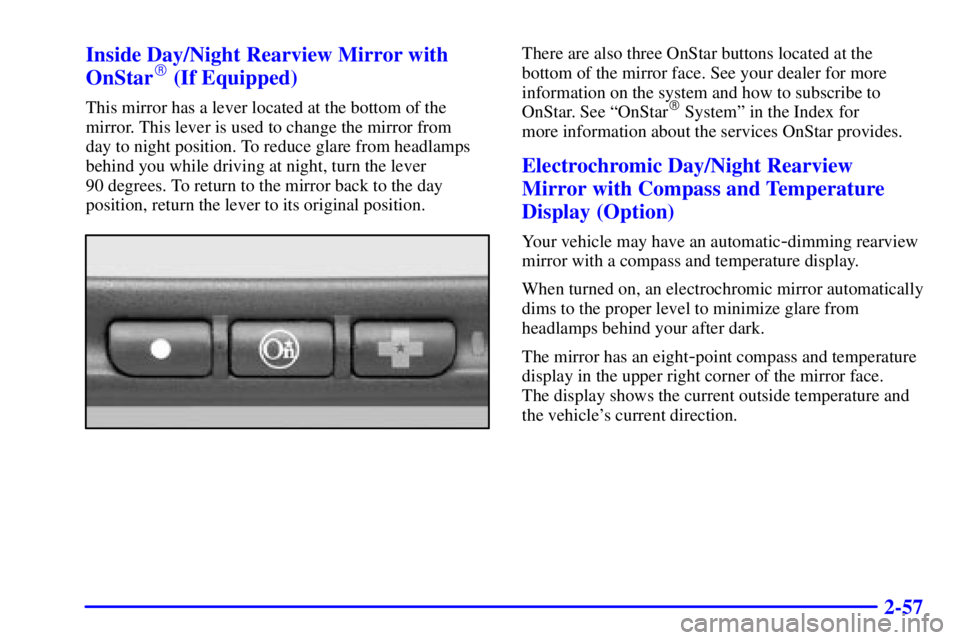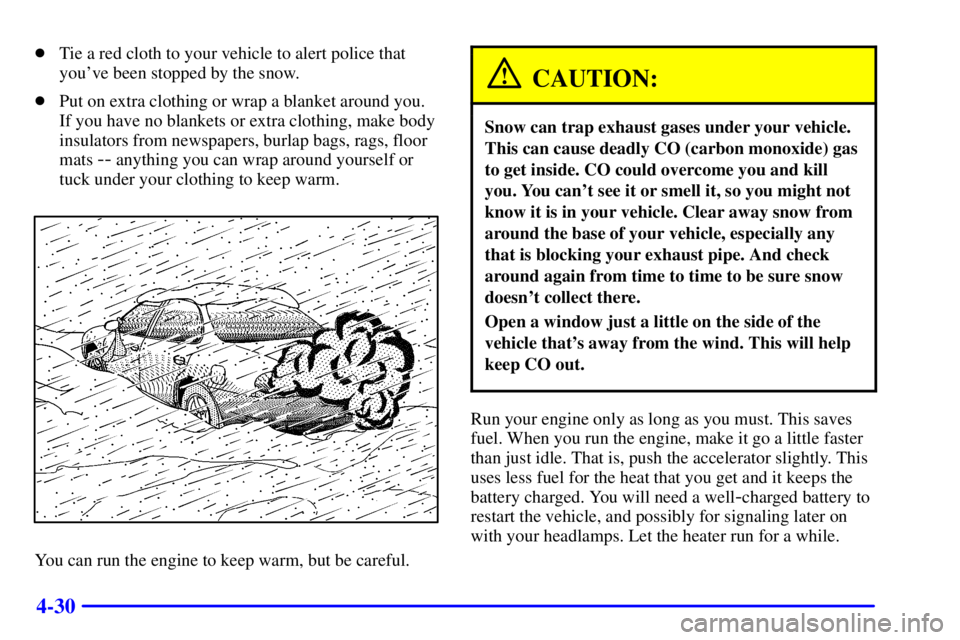Page 121 of 373

2-52
Exterior Lamps
The lamp controls are located on the lower left side of
the instrument panel, to the left of the steering wheel.
They control the following systems:
�Headlamps
�Taillamps
�Parking Lamps
�License Lamps�Sidemarker Lamps
�Instrument Panel Lights
�Courtesy Lamps
: Turn the knob to this symbol to turn on the
headlamps and other operating lamps.
: Turn the knob to this symbol to turn on
the parking and other operating lamps without
the headlamps.
Turn the knob to OFF to turn off the lamps.
A warning chime will sound if you open the driver's
door when you turn the ignition switch to LOCK or
ACCESSORY with the lamps on.
Daytime Running Lamps / Automatic
Headlamp Control
Daytime Running Lamps (DRL) can make it easier for
others to see the front of your vehicle during the day.
DRL can be helpful in many different driving
conditions, but they can be especially helpful in the
short periods after dawn and before sunset. Fully
functional daytime running lights are required on all
vehicles first sold in Canada.
A light sensor on top of the instrument panel makes the
DRL work, so be sure it isn't covered.
Page 122 of 373

2-53
The DRL system will make your low-beam headlamps
come on at a reduced brightness when the following
conditions are met:
�The ignition is on,
�the headlamp switch is off,
�the transaxle is not in PARK (P) and
�the parking brake is released.
When the DRL are on, only your low
-beam headlamps,
at a reduced brightness, will be on. The taillamps,
sidemarker and other lamps won't be on. Your
instrument panel won't be lit up either.
When it's dark enough outside, your headlamps will
change to full brightness. The other lamps that come on
with your headlamps will also come on.
When it's bright enough outside, the regular lamps will
go out, and your low
-beam headlamps change to the
reduced brightness of DRL.
To idle your vehicle with the DRL off, set the parking
brake while the ignition is in OFF or LOCK. Then start
your vehicle. The DRL will stay off until you shift out
of PARK (P) and release the parking brake.
As with any vehicle, you should turn on the regular
headlamp system when you need it.
Fog Lamps
The fog lamp switch is located in the upper corner
of the instrument panel, to the left of the instrument
panel cluster.
To turn the fog lamps on, press the right side of the fog
lamp switch. A light will glow on the switch to let you
know that they are on. (The parking lamps must be on,
or the fog lamps won't come on.) Press the left side of
the switch to turn the fog lamps off.
The fog lamps will go off whenever you change to
high
-beam headlamps. When you return to low beams,
the fog lamps will come on again.
Page 126 of 373

2-57 Inside Day/Night Rearview Mirror with
OnStar
� (If Equipped)
This mirror has a lever located at the bottom of the
mirror. This lever is used to change the mirror from
day to night position. To reduce glare from headlamps
behind you while driving at night, turn the lever
90 degrees. To return to the mirror back to the day
position, return the lever to its original position.
There are also three OnStar buttons located at the
bottom of the mirror face. See your dealer for more
information on the system and how to subscribe to
OnStar. See ªOnStar
� Systemº in the Index for
more information about the services OnStar provides.
Electrochromic Day/Night Rearview
Mirror with Compass and Temperature
Display (Option)
Your vehicle may have an automatic-dimming rearview
mirror with a compass and temperature display.
When turned on, an electrochromic mirror automatically
dims to the proper level to minimize glare from
headlamps behind your after dark.
The mirror has an eight
-point compass and temperature
display in the upper right corner of the mirror face.
The display shows the current outside temperature and
the vehicle's current direction.
Page 163 of 373

2-94
To adjust the HUD so you can see it properly do
the following:
1. Start your engine and turn the DIM thumbwheel to
the desired HUD image brightness.
2. Adjust your seat, if necessary, to a
comfortable position.
3. Press the top of the UP/DN switch until the HUD
image stops moving. Then press the bottom of the
switch until the image is as low as possible but in
full view.4. Turn the DIM thumbwheel down until the HUD
image is no brighter than necessary. To turn the HUD
off, turn the DIM thumbwheel all the way down.
If the sun comes out, it becomes cloudy, or if you turn
on your headlamps, you may need to adjust the HUD
brightness again. Polarized sunglasses could make the
HUD image harder to see.
Push the ENG/MET button
on the trip calculator,
located above the audio
controls on the trip
computer (if equipped) on
the instrument panel, to
switch the HUD display
from English to metric or
metric to English.
If your vehicle is not equipped with the trip calculator,
you cannot change the display.
Page 203 of 373

4-17
Driving at Night
Night driving is more dangerous than day driving.
One reason is that some drivers are likely to be
impaired
-- by alcohol or drugs, with night vision
problems, or by fatigue.Here are some tips on night driving.
�Drive defensively.
�Don't drink and drive.
�Adjust your inside rearview mirror to reduce the
glare from headlamps behind you.
�Since you can't see as well, you may need to
slow down and keep more space between you and
other vehicles.
�Slow down, especially on higher speed roads. Your
headlamps can light up only so much road ahead.
�In remote areas, watch for animals.
�If you're tired, pull off the road in a safe place
and rest.
No one can see as well at night as in the daytime. But as
we get older these differences increase. A 50
-year-old
driver may require at least twice as much light to see the
same thing at night as a 20
-year-old.
What you do in the daytime can also affect your night
vision. For example, if you spend the day in bright
sunshine you are wise to wear sunglasses. Your eyes
will have less trouble adjusting to night. But if you're
driving, don't wear sunglasses at night. They may cut
down on glare from headlamps, but they also make a lot
of things invisible.
Page 204 of 373

4-18
You can be temporarily blinded by approaching
headlamps. It can take a second or two, or even several
seconds, for your eyes to readjust to the dark. When you
are faced with severe glare (as from a driver who
doesn't lower the high beams, or a vehicle with
misaimed headlamps), slow down a little. Avoid staring
directly into the approaching headlamps.
Keep your windshield and all the glass on your vehicle
clean
-- inside and out. Glare at night is made much
worse by dirt on the glass. Even the inside of the glass
can build up a film caused by dust. Dirty glass makes
lights dazzle and flash more than clean glass would,
making the pupils of your eyes contract repeatedly.
Remember that your headlamps light up far less of a
roadway when you are in a turn or curve. Keep your
eyes moving; that way, it's easier to pick out dimly
lighted objects. Just as your headlamps should be
checked regularly for proper aim, so should your eyes
be examined regularly. Some drivers suffer from night
blindness
-- the inability to see in dim light -- and
aren't even aware of it.
Driving in Rain and on Wet Roads
Rain and wet roads can mean driving trouble. On a wet
road, you can't stop, accelerate or turn as well because
your tire
-to-road traction isn't as good as on dry roads.
And, if your tires don't have much tread left, you'll get
even less traction. It's always wise to go slower and be
cautious if rain starts to fall while you are driving. The
surface may get wet suddenly when your reflexes are
tuned for driving on dry pavement.
Page 216 of 373

4-30
�Tie a red cloth to your vehicle to alert police that
you've been stopped by the snow.
�Put on extra clothing or wrap a blanket around you.
If you have no blankets or extra clothing, make body
insulators from newspapers, burlap bags, rags, floor
mats
-- anything you can wrap around yourself or
tuck under your clothing to keep warm.
You can run the engine to keep warm, but be careful.
CAUTION:
Snow can trap exhaust gases under your vehicle.
This can cause deadly CO (carbon monoxide) gas
to get inside. CO could overcome you and kill
you. You can't see it or smell it, so you might not
know it is in your vehicle. Clear away snow from
around the base of your vehicle, especially any
that is blocking your exhaust pipe. And check
around again from time to time to be sure snow
doesn't collect there.
Open a window just a little on the side of the
vehicle that's away from the wind. This will help
keep CO out.
Run your engine only as long as you must. This saves
fuel. When you run the engine, make it go a little faster
than just idle. That is, push the accelerator slightly. This
uses less fuel for the heat that you get and it keeps the
battery charged. You will need a well
-charged battery to
restart the vehicle, and possibly for signaling later on
with your headlamps. Let the heater run for a while.
Page 300 of 373
6-38
Bulb Replacement
In this section, you'll find directions for changing the
bulbs on your vehicle. See ªReplacement Bulbsº in
the Index to find the type of bulb you should use.
For any bulb changing procedure not listed in this
section, contact the service department of your dealer.
Halogen Bulbs
CAUTION:
Halogen bulbs have pressurized gas inside and
can burst if you drop or scratch the bulb. You or
others could be injured. Be sure to read and
follow the instructions on the bulb package.
Headlamps
To replace the headlamps, do the following:
1. Open the hood and support it properly.
2. Remove the two bolts
from the top of the
headlamp assembly.